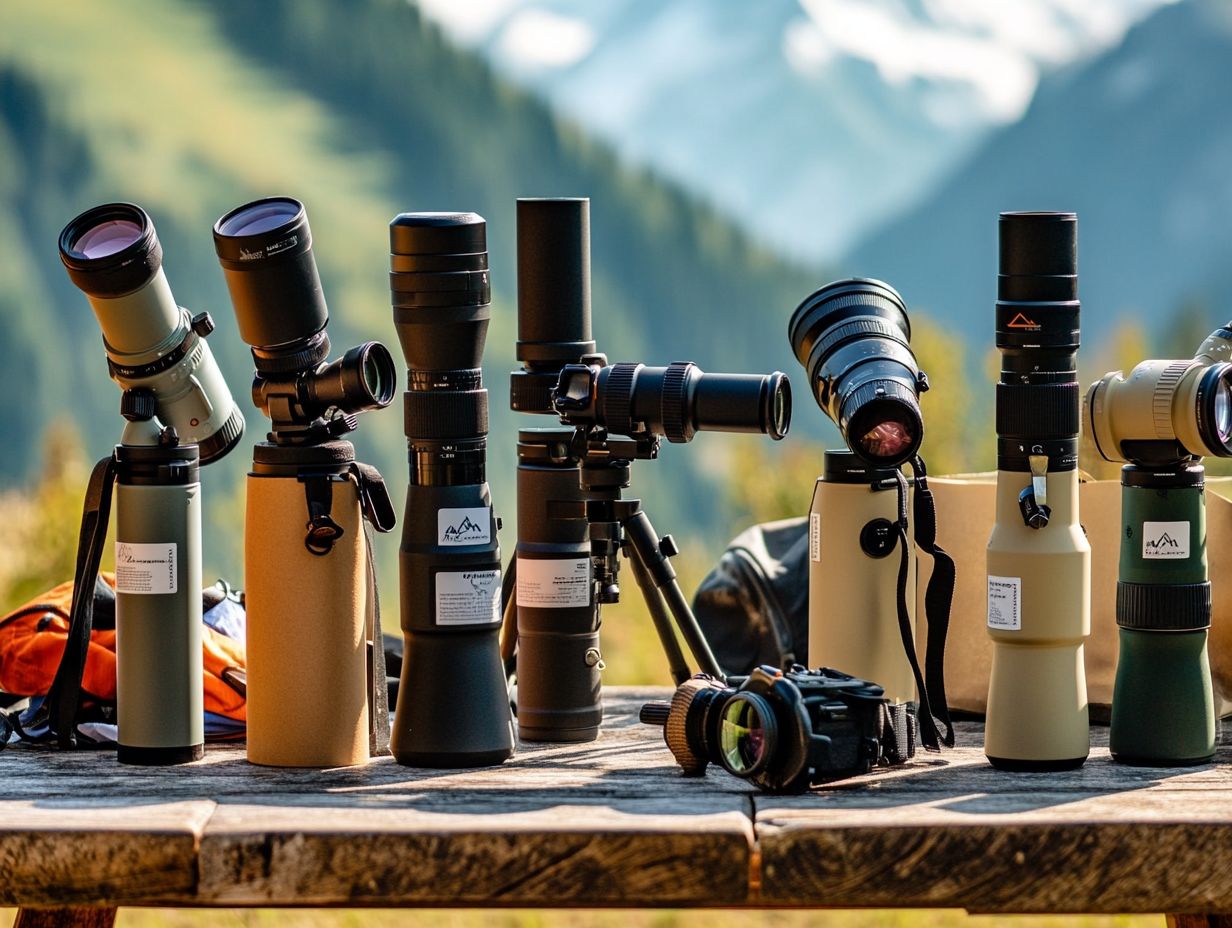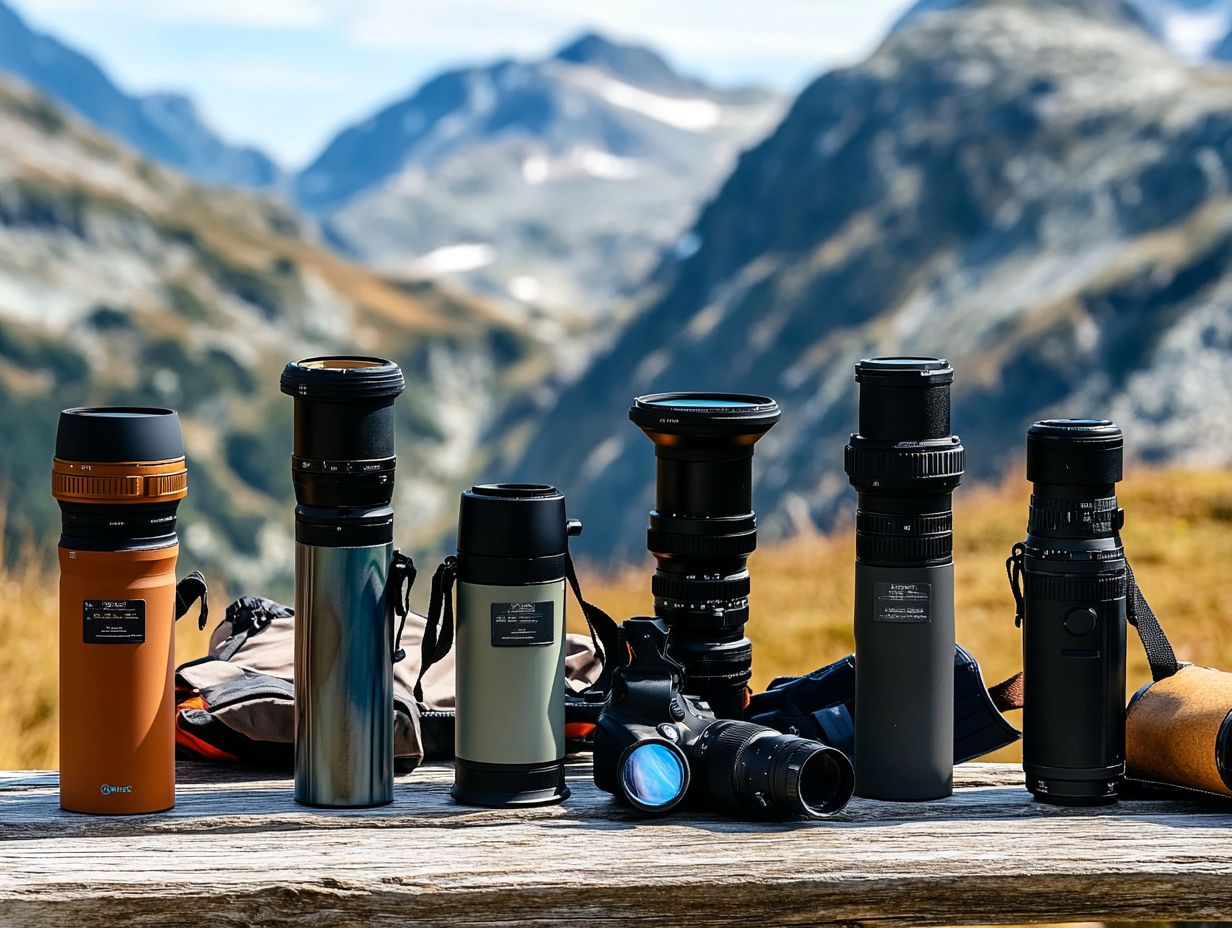Spotting Scope Buying Guide: What You Need to Know
If you re on the hunt for a spotting scope, you re probably looking to elevate your outdoor experiences with enhanced clarity and detail be it for birdwatching, hunting, or stargazing.
This guide will walk you through the essential factors to consider before making your purchase, including magnification, field of view, and durability.
You ll also discover the various types of spotting scopes, useful accessories, and expert tips for optimal usage.
By the end of this guide, you ll be ready to choose the perfect spotting scope that fits your needs.
Contents
- Key Takeaways:
- What is a Spotting Scope?
- Factors to Consider Before Buying
- Field of View and Eye Relief
- Prism Type and Coatings
- Weatherproofing and Durability
- Types of Spotting Scopes
- Accessories for Spotting Scopes
- Tips for Using a Spotting Scope
- Frequently Asked Questions
- What is a spotting scope and why do I need one?
- What should I consider when buying a spotting scope?
- What is the difference between straight and angled spotting scopes?
- What is the importance of magnification power?
- What is the significance of main lens size?
- What are the different types of prisms used in spotting scopes?
Key Takeaways:

- Consider magnification, the diameter of the front lens, field of view, and eye relief when buying a spotting scope for the best viewing experience.
- Choose between straight or angled scopes and compact or full-size scopes based on your specific needs and preferences.
- Invest in accessories like tripods, mounts, and camera adapters to enhance the functionality and versatility of your spotting scope.
What is a Spotting Scope?
A spotting scope is a sophisticated, high-power telescope crafted for outdoor pursuits that demand enhanced magnification. It enables you to observe distant objects with exceptional clarity.
These versatile instruments are essential for activities such as birdwatching, hunting, and nature observation, delivering crystal-clear image quality and outstanding optical performance.
Equipped with durable optics, waterproof and fogproof construction, and special coatings that improve image quality, spotting scopes enhance light transmission and image resolution. This makes them essential gear for enthusiasts eager to immerse themselves in the wonders of the great outdoors.
Factors to Consider Before Buying
When selecting the ideal spotting scope, consider several critical factors that can greatly impact your experience and satisfaction. Key elements like understanding spotting scope specifications, the diameter of the front lens, and the overall weight and dimensions of the unit play a vital role.
Opting for the right specifications is essential to ensure optimal performance in varying conditions, whether you find yourself in low light or need effective glassing over long distances. Focusing on durable optics and quality lens coatings will significantly enhance your viewing experience.
Also, factor in user comfort and budget considerations to tailor the perfect scope to your specific needs.
Magnification and Objective Lens Size
The magnification and the diameter of the front lens are two essential specifications that significantly influence the performance and usability of a spotting scope. These factors determine how well you can observe distant objects and the quality of the images you produce.
A higher magnification enables you to enjoy more detailed views of wildlife or landscapes, while the size of the objective lens is crucial for gathering light, which is particularly important for image clarity in low-light situations.
For example, if you opt for a spotting scope with a magnification range of 20-60x and pair it with a large 80mm objective lens, you ll experience bright, sharp images perfect for birdwatching at dawn or dusk when light is scarce.
On the other hand, a scope with lower magnification and a smaller objective lens may struggle to provide the same level of detail and brightness, leaving you wanting during those critical viewing moments.
By understanding how these specifications work together, you can greatly enhance your viewing experience and select the right equipment tailored to your specific observational needs.
Field of View and Eye Relief
Field of view and eye relief are essential elements in the usability of a spotting scope, directly influencing how comfortably and effectively you can observe distant subjects. A wider field of view allows you to track moving objects with ease, while adequate eye relief is crucial for comfortable, prolonged viewing especially if you wear glasses.
Both features significantly enhance the clarity and sharpness of the images you observe. When you’re out birdwatching or hunting, having an expansive field of view not only makes it easier to spot and follow targets. It also reduces eye strain during extended use.
Eye relief is equally important; for those who wear spectacles, scopes with generous eye relief minimize the hassle of adjusting and repositioning, leading to a more immersive experience. In practical terms, these attributes elevate your overall satisfaction, ensuring that every observation is enjoyable and effective.
Prism Type and Coatings

Understanding the type of prism used in your spotting scope, along with the coatings applied to its lenses, is essential for optimizing image quality and performance. Common prism types like Bak4 prisms enhance light transmission and image clarity. Specialized lens coatings, such as ED coatings, which help to reduce color distortion, enhance your viewing experience.
These components significantly influence how well your spotting scope performs, especially in challenging environments. For example, low-light conditions can pose visibility challenges. However, quality prisms paired with advanced coatings ensure you experience crisp, vibrant imagery.
Exploring alternatives like Porro prisms can reveal additional options if you’re looking for specific features, such as a wider field of view. Ultimately, grasping these elements enables you to select the right equipment, tailoring your scouting experience to meet your unique needs and the environmental challenges you face.
Weatherproofing and Durability
The weatherproofing and durability of a spotting scope are essential features that guarantee reliability and performance, particularly during your outdoor adventures such as hunting or birdwatching in challenging conditions. A waterproof and fogproof design safeguards the internal components from moisture and dust. A rugged build extends the lifespan of the optics, giving you peace of mind in unpredictable environments.
So, whether you’re in pouring rain or navigating misty landscapes, your scope stays reliable and clear, so you can dive into your adventure without worry! You can focus on spotting elusive wildlife or tracking distant targets without the nagging worry of equipment failure.
These features contribute to a superior user experience, allowing you to trust that your optics will perform reliably in various settings. This ensures extended use and improved visibility, ultimately elevating your outdoor adventures.
Types of Spotting Scopes
Spotting scopes come in several types, each meticulously crafted to meet distinct needs and preferences. Whether you prefer straight or angled configurations or lean towards compact versus full-size options, consider your intended use and desired optical performance. For more insights, explore the top features to look for in a spotting scope.
Each decision shapes your experience, enhancing the joy of your outdoor pursuits. Ready to find the perfect spotting scope? Dive into our selection and gear up for your next adventure!
Straight vs. Angled
The decision between straight and angled spotting scopes largely hinges on your personal preference and the specific viewing circumstances you encounter.
Straight scopes provide a direct line of sight, making them perfect for quick targeting. In contrast, angled scopes often enhance comfort during extended observations, reducing neck strain and offering various positioning options.
If you enjoy activities like hunting or birdwatching, where rapid adjustments are crucial, you’ll likely find straight scopes more appealing.
However, if your interests lie in astronomy or photography, angled scopes stand out by providing stability and a comfortable eyeline, significantly elevating your experience.
For those navigating challenging terrains or elevated landscapes, an angled scope allows for easier alignment without the need to hunch over. This makes it a favored option.
Ultimately, considering these factors will help you select the spotting scope that best aligns with your individual observational needs. For those starting out, spotting scope use tips for beginners can ensure both comfort and exceptional viewing quality.
Compact vs. Full-size
Choosing between compact and full-size spotting scopes is all about weighing portability against optical performance, with each design offering distinct benefits.
Compact models are lightweight and easy to carry, making them ideal for hiking or travel adventures. On the other hand, full-size scopes typically deliver superior image quality and stability, especially at higher magnifications.
Understanding your intended use is essential. Compact scopes excel when space and weight are priorities, such as during birdwatching trips or outdoor events.
Their convenience often appeals to those who value mobility over prolonged viewing sessions.
In contrast, full-size models shine in situations that require detailed observation think wildlife photography or stargazing, where extended use and higher optical power are crucial.
Ultimately, the decision rests on your personal preferences and the specific demands of your activities, whether you prioritize effortless transport or seek unparalleled visual clarity.
Accessories for Spotting Scopes

Using a spotting scope can be greatly enhanced with several accessories. Tripod supports and digiscoping adapters which let you use a camera with your spotting scope offer stable viewing and allow for high-quality images.
These accessories enhance your comfort during extended observations and enable you to document your adventures and findings with remarkable clarity.
Tripods and Mounts
Tripods and mounts are essential companions for your spotting scopes, providing the stability needed for optimal optical performance during long viewing sessions.
A sturdy tripod minimizes vibrations, allowing you to observe comfortably without straining, helping you focus on intricate details.
You ll find various tripods to suit your needs, from lightweight, portable options ideal for hiking to robust, heavy-duty models designed for long-term setups.
Some mounts even offer adjustable heights and swivel capabilities, allowing for easy tracking of moving subjects.
The materials used whether aluminum or carbon fiber impact their weight and stability significantly. Selecting one that aligns with your specific requirements is essential.
When properly equipped, these tripods and mounts not only enhance your comfort but also elevate your overall viewing experience by ensuring an unobstructed line of sight.
Explore your options today!
Camera Adapters
Camera adapters, including digiscoping adapters, enable you to connect your camera to spotting scopes, effortlessly blending the realms of optics and photography. This capability is particularly advantageous for nature enthusiasts and wildlife photographers eager to document their encounters with remarkable clarity and detail.
By harnessing these adapters, you can easily capture breathtaking images and videos that reveal the intricate details of distant subjects whether it’s that elusive bird perched high in a tree or a stunning landscape unfolding before your eyes.
It s not just about enhancing image quality; the convenience of a camera adapter elevates your entire experience. Get ready for quick and smooth setups that let you dive right into capturing stunning moments!
With the right combination of camera and adapter, you can achieve professional-quality results, enabling you to share your adventures and the beauty of nature with friends, family, or even a broader audience. This fosters a deeper appreciation for the wonders of the natural world.
Start capturing nature’s beauty today!
Tips for Using a Spotting Scope
To truly maximize the performance of your spotting scope, it s essential to grasp the importance of proper setup and maintenance practices. This understanding ensures that you achieve the best possible image clarity and extend the life of your equipment.
- Regular cleaning and precise adjustments.
- Secure storage to enhance your viewing experience.
- Choosing the right location for setup.
Proper Setup and Maintenance
Proper setup and maintenance of your spotting scope are essential for ensuring longevity and achieving optimal optical quality, significantly enhancing your overall viewing experience. Start with the basics: use a stable tripod, adjust the focus with precision, and regularly clean the lenses to keep dust and smudges at bay, ensuring a crystal-clear view.
These foundational practices are essential. Choose a location with minimal heat distortion and clear sightlines for sharper observations. It s wise to check and calibrate the scope’s alignment periodically to maintain pinpoint accuracy. Always store the scope in a protective case when not in use; this protects it from moisture, dirt, and accidental damage.
By keeping these considerations in mind, you will not only extend the life of your equipment but also elevate the clarity and enjoyment of your viewing sessions.
Frequently Asked Questions

What is a spotting scope and why do I need one?
A spotting scope is a portable, powerful telescope that helps you see distant things clearly. It is commonly used for activities such as birdwatching, hunting, and target shooting. It provides a clearer and more detailed view than regular binoculars, making it a valuable tool for outdoor enthusiasts.
What should I consider when buying a spotting scope?
There are several important factors to consider when purchasing a spotting scope, including the magnification power, objective lens size, type of prism, and overall size and weight. For a deeper understanding, refer to spotting scope optics. It’s also important to consider your specific needs and budget to find the best fit for you.
What is the difference between straight and angled spotting scopes?
Straight spotting scopes have an eyepiece that is in line with the body of the scope, while angled spotting scopes have an angled eyepiece. Straight scopes are typically easier to use and better for viewing objects at eye level, while angled scopes provide a more comfortable viewing angle for extended use and are better for viewing objects at different heights.
What is the importance of magnification power?
The magnification power determines how much the scope can magnify the image of the object being viewed. Higher magnification may seem desirable, but it can also decrease the clarity and stability of the image. It’s important to find a balance between magnification and image quality, depending on your intended use.
Find the perfect spotting scope today to elevate your viewing adventures!
What is the significance of main lens size?
The main lens gathers light and produces a bright, clear image. Larger lenses let in more light, creating a brighter image.
However, larger lenses also make the scope heavier and bulkier. Consider the balance between image quality and portability.
What are the different types of prisms used in spotting scopes?
The two main types of prisms in spotting scopes are roof prisms and porro prisms. Roof prisms are compact and lightweight, offering a straighter design.
Porro prisms tend to be larger and heavier. They often provide a wider field of view and better image quality.






